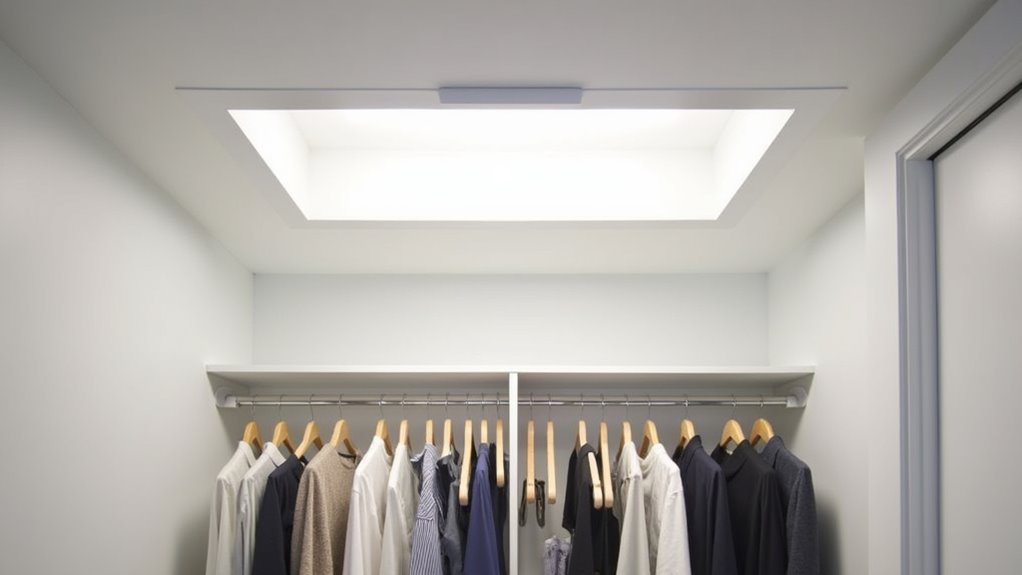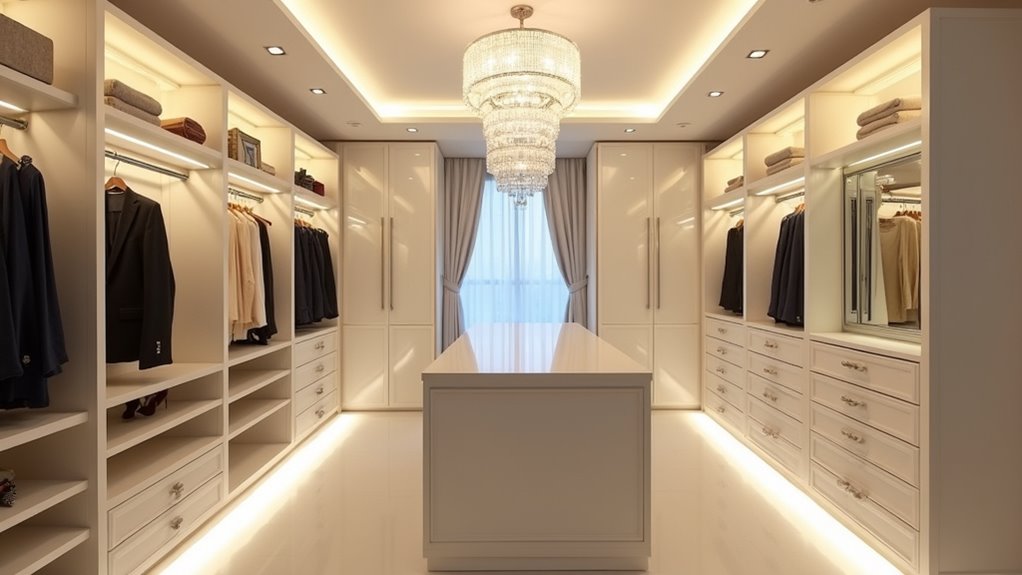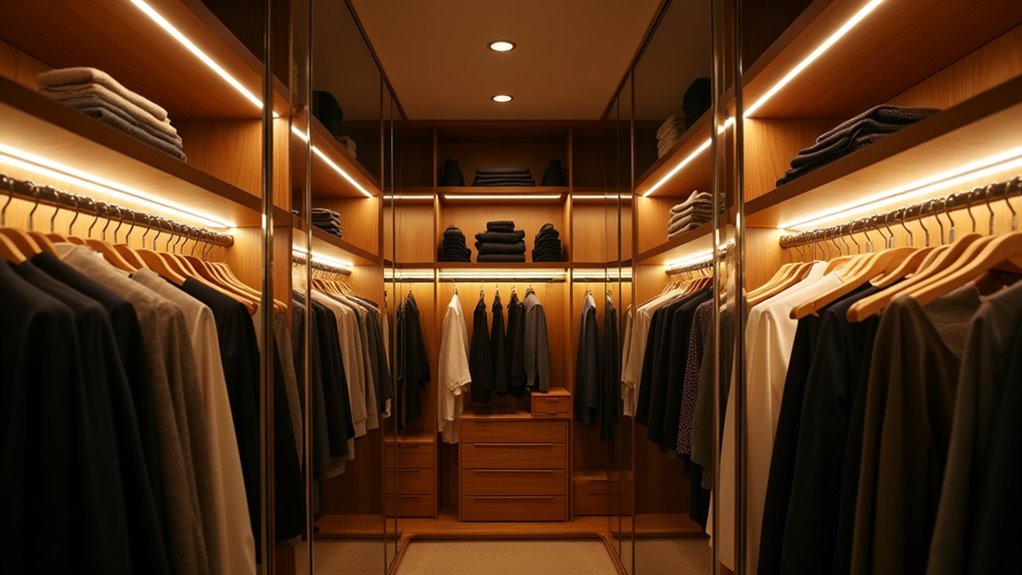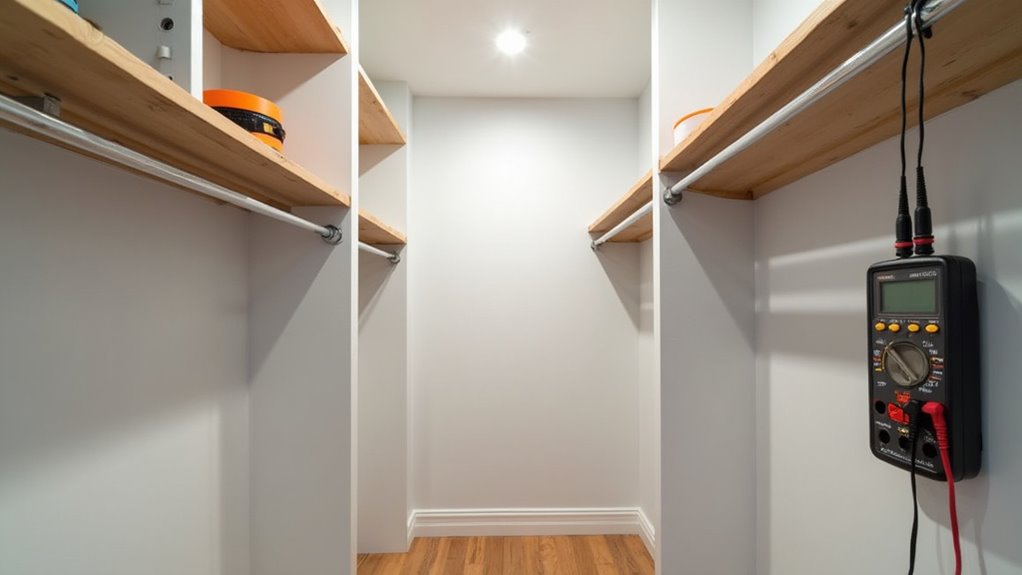You’ll need to follow NEC Section 410.16, which mandates completely enclosed incandescent or LED fixtures with 12-inch clearance from storage areas, while fluorescent fixtures require only 6 inches. You can’t use pendant lights, open bulbs, or pull-chain fixtures; they’re prohibited fire hazards. Surface-mounted fixtures must be identified as closet-rated, and recessed units need 6-inch minimum clearances. IRC Section E4003.12 requires wall-switch operation for all closet lighting. Understanding these specific requirements and proper measurement techniques will help you avoid dangerous violations and guarantee your installation passes inspection.
Approved Fixture Types for Clothes Closet Installation
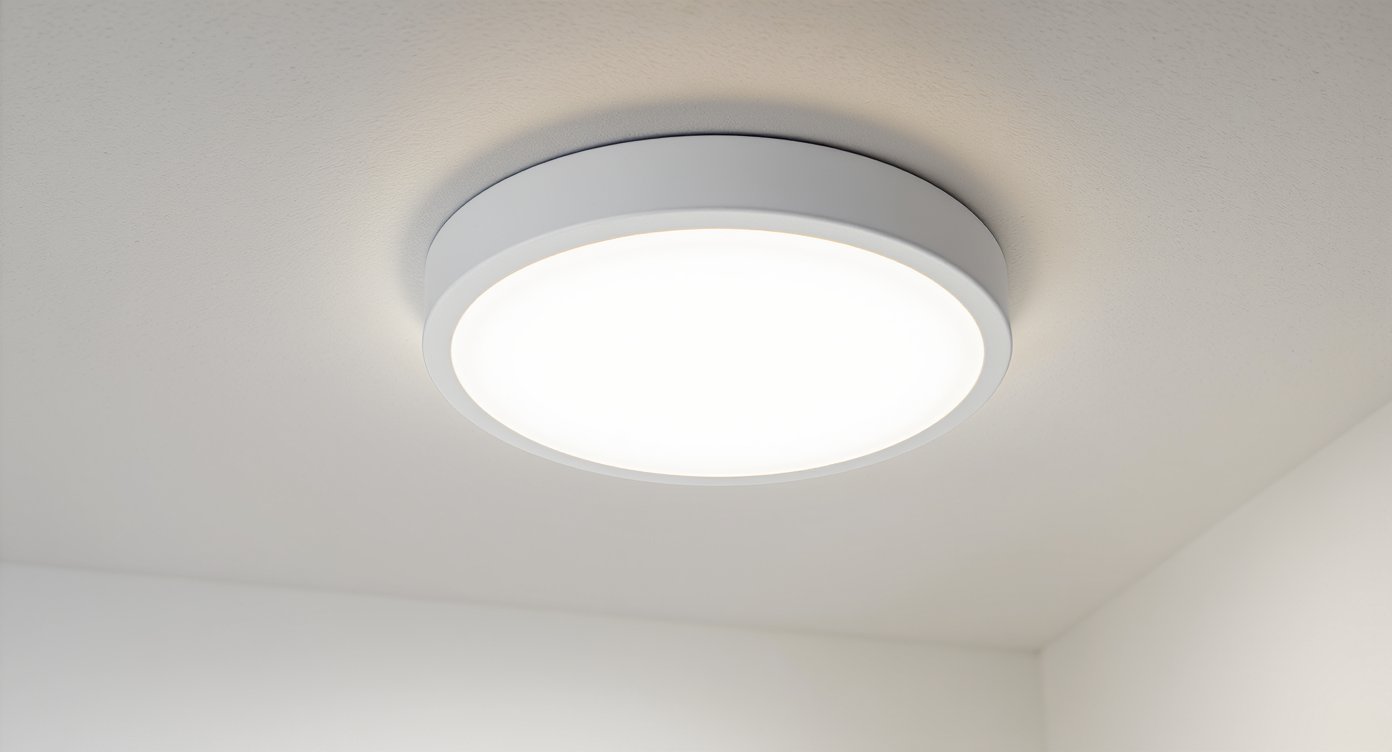
The National Electrical Code (NEC) and International Residential Code (IRC) establish strict criteria for luminaire types permissible in clothes closets, prioritizing fire prevention in spaces with combustible materials. You’re permitted to install surface-mounted or recessed incandescent luminaires with completely enclosed lamps, plus surface-mounted or recessed LED fixtures featuring fully enclosed light sources. Surface-mounted or recessed fluorescent luminaires also qualify, provided they aren’t open-bulb designs. Contractor responsibilities include verifying that surface-mounted fluorescent or LED fixtures carry manufacturer labels specifically identifying suitability for installation within closet storage space. Pendant lights, open-bulb fixtures, and partially enclosed lamps don’t meet approval standards and can’t be counted as compliant options. Incandescent bulbs run hot and can ignite nearby combustible materials if left on, which is why partially enclosed fixtures are prohibited even though they were common in older homes. Section 410.16 of the NEC (NFPA 70-2017) outlines these specific mandates for closet lighting installations. Motion-activated LED fixtures designed for wall or ceiling mounting provide a practical solution for closets where identifying compliant fixtures can be challenging. Homeowner maintenance considerations involve confirming UL or equivalent NRTL certification markings, ensuring fixtures passed thermal and fire-safety tests required for enclosed spaces.
Prohibited Lighting Fixtures That Create Fire Hazards
While approved fixtures provide safe illumination options, numerous lighting types remain expressly prohibited in closet installations under NEC Article 410.16 and IRC Section M1505.4 due to documented fire hazards. Understanding these restrictions prevents dangerous violations that compromise household safety.
Prohibited fixture categories include:
- Open or partially enclosed incandescent bulbs that allow direct contact between hot surfaces and combustible materials like clothing or cardboard
- Pendant fixtures and hanging lampholders that position heat sources within reach of stored items and create uneven thermal distribution
- Bare or unenclosed LED bulbs unless specifically listed as suitable for storage areas, since enclosure requirements transcend bulb technology
- Improvised or modified fixtures lacking manufacturer certification for closet use, including DIY installations with removed protective covers
- Pull chain plastic/porcelain base incandescent fixtures that fail to provide adequate enclosure and protection against fire hazards
Alternative retrofit options must maintain complete enclosure standards. Risks of fixture removal during modifications can expose wiring and eliminate essential fire barriers required by code. The storage space boundary extends 24 inches from walls and defines the restricted zone where heat-producing fixtures pose the greatest combustion risk. The #1 lighting fire hazard in closets remains the bare-bulb light fixture, which exposes hot surfaces directly to combustible storage materials.
Minimum Clearance Distances Between Fixtures and Storage Areas
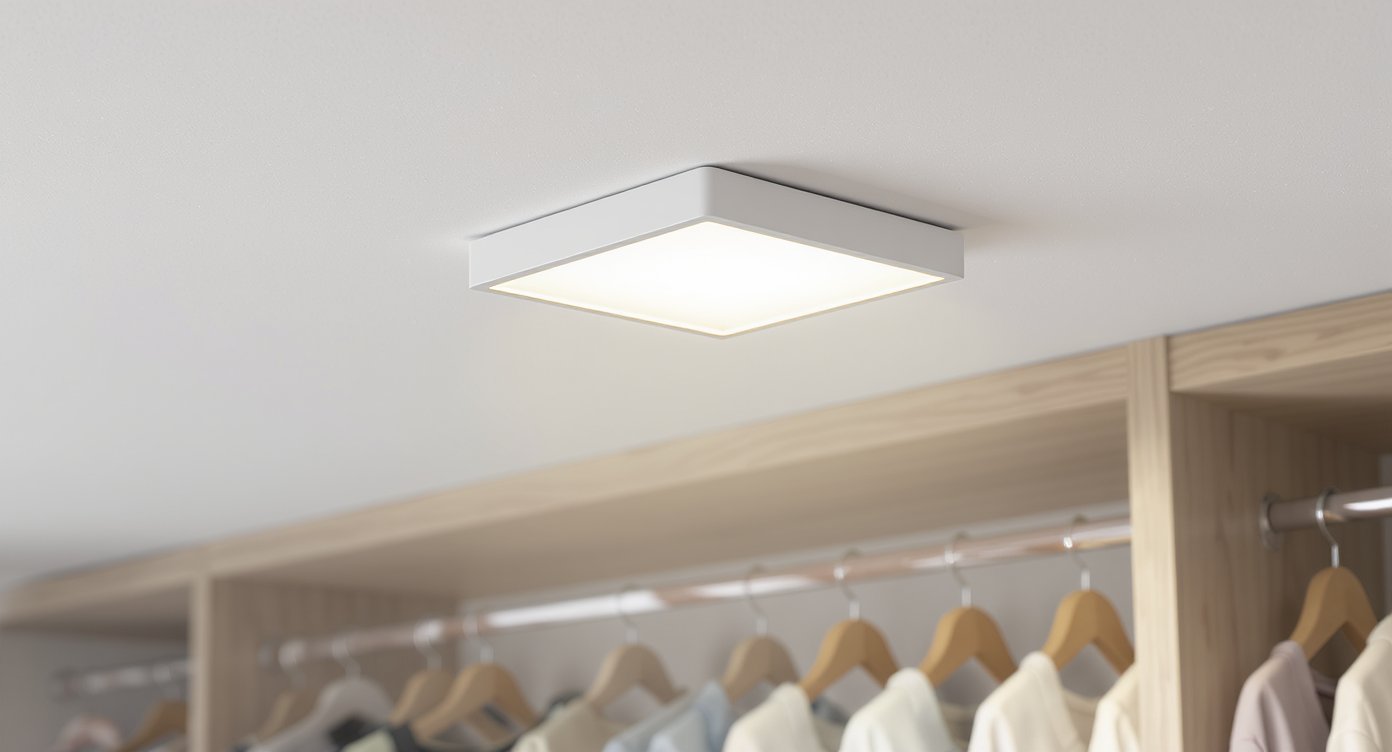
You must maintain specific clearance distances between lighting fixtures and closet storage space to prevent fire hazards from heat buildup on combustible materials. Surface-mounted incandescent or LED fixtures require 12 inches of clearance from storage boundaries, while recessed fixtures need only 6 inches. These measurements apply to the defined storage space, not just the physical wall, which extends 24 inches horizontally from walls and includes areas below rods and above shelving. Any socket that can accept an incandescent bulb is classified as an incandescent fixture and must follow these clearance requirements. Section 410.16 of NEC establishes these clearance requirements to ensure compliance with national electrical standards for luminaires in clothes closets.
Surface-Mounted Fixture Clearances
Understanding proper clearance requirements prevents fire hazards and guarantees code compliance when installing surface-mounted fixtures in closets. You’ll need to maintain specific distances based on your fixture type and installation location.
Surface-Mounted Fixture Clearance Requirements:
- Incandescent/LED fixtures require 12 inches minimum clearance from storage areas when mounted on walls above doors or ceilings, with only completely enclosed lamps permitted
- Fluorescent luminaires need just 6 inches clearance due to reduced thermal output, improving lighting accessibility in compact spaces
- Closet-rated fixtures allow zero clearance when specifically identified and listed for storage space installation, maximizing fixture efficiency
- Prohibited configurations include open or partially enclosed fixtures, pendant luminaires, and bare bulbs regardless of technology type
Installation below these minimum distances creates code violations and significant fire risks requiring immediate correction. Surface-mounted LED fixtures are permitted in clothes closets when identified as suitable for that specific application through proper listing or labeling.
Recessed Fixture Clearances
How far must recessed fixtures be positioned from your closet’s storage areas? NEC 410.16 mandates a 6-inch minimum clearance between recessed incandescent, LED, or fluorescent fixtures and the nearest storage space, whether that’s a shelf, hanging rod, or stacked items. This measurement extends from the fixture’s edge to any point where items could potentially be stored. Fixture placement orientation matters greatly: you can’t reduce clearances by angling installations. If your shelving exceeds 12 inches in depth, measure from the shelf’s outer edge, not the wall. Accessibility considerations require that fixtures mustn’t interfere with door operation or user movement. Only fixtures specifically labeled “suitable for installation within the closet storage area” bypass these clearances, though such listings are uncommon for recessed types. Recent NEC updates have increased voltage thresholds from 600 volts to 1000 volts in many articles to accommodate newer technologies, though this change does not directly impact residential closet lighting requirements. Always verify requirements with your local Authority Having Jurisdiction.
Understanding Surface-Mounted vs. Recessed Fixture Requirements
When selecting closet lighting, you’ll need to understand that surface-mounted and recessed fixtures have distinctly different clearance requirements from storage areas. Surface-mounted incandescent or LED fixtures require 12 inches of clearance, while their recessed counterparts need only 6 inches, a critical difference that directly impacts your installation options in compact closets. You must evaluate your available clearance distances and storage configuration before choosing between mounting types to guarantee code compliance and fire safety.
Surface-Mounted Fixture Clearances
Anyone installing closet lighting must understand that surface-mounted fixtures carry different clearance requirements than their recessed counterparts, and these distinctions directly impact code compliance. Standard surface-mounted incandescent or LED fixtures require 12 inches clearance from storage areas when ceiling-mounted, while fluorescent fixtures need only 6 inches. However, fixtures meeting fixture labeling guidelines as closet-rated require zero clearance, enabling flexible installation configurations.
Critical clearance requirements include:
- Measuring distance from fixture edge to nearest storage point (shelf edge, hanging rod)
- Ensuring fully enclosed lamp design for non-closet-rated surface fixtures
- Verifying manufacturer labeling or UL certification for closet-rated designation
- Prohibiting open bulbs and pendant fixtures regardless of clearance distance
You’ll violate code by installing standard surface fixtures within required clearance zones, creating fire hazards and inspection failures.
Recessed Fixture Installation Rules
While surface-mounted fixtures dominated earlier closet lighting discussions, recessed luminaires present distinctly different code requirements that you must address before cutting ceiling openings.
NEC Article 410 mandates IC-rated housings where insulation contacts fixtures directly. You’ll need proper fire resistance ratings for ceiling assemblies, with fire-stopping measures required in rated constructions. Air-seal all penetrations per IECC standards using gaskets or caulk.
| Requirement | IC-Rated | Non-IC-Rated |
|---|---|---|
| Insulation Contact | Permitted | 3″ clearance minimum |
| Thermal Protection | Required/labeled | Required/labeled |
| Air Sealing | Mandatory | Mandatory |
Your wiring methods must follow NEC standards, connections occur only in integral junction boxes, with proper grounding of metallic components. Install damp-location fixtures in closets with moisture exposure. Always secure housings to structural framing, never solely to ceiling materials. Space fixtures 4-6 feet apart to ensure even distribution of light throughout the closet. Recessed luminaires must maintain an air leakage rate not exceeding 2.0 cfm when sealed to limit airflow between conditioned and unconditioned spaces.
Select energy-efficient LED fixtures to reduce long-term operational costs and comply with local energy codes that set minimum efficiency standards for residential installations.
Choosing Between Mounting Types
Before you purchase any closet fixture, you must understand how surface-mounted and recessed luminaires differ in their regulatory requirements, because your choice directly impacts clearance distances, installation complexity, and code compliance pathways. Surface-mounted fixtures demand 12 inches clearance for enclosed incandescent/LED types or 6 inches for fluorescent, while recessed fixtures require only 6 inches from storage. Both types must feature fully enclosed light sources unless specifically closet-rated.
Space planning considerations and installation factors:
- Recessed lighting aesthetics eliminate protrusion into limited closet space, maximizing vertical clearance
- Surface-mounted closet-rated fluorescent or LED fixtures allow zero-clearance installation within storage areas
- Recessed installations require attic/joist access and IC-rated housings for insulation contact
- Surface-mounted options simplify retrofits when ceiling cavity access isn’t available or economical
- Pendant fixtures and open/partially enclosed lamps are prohibited in closets regardless of mounting configuration
Special Provisions for Closet-Rated Lighting Products
Closet-rated lighting products represent a specialized category of luminaires that have undergone rigorous certification testing to verify safe operation within clothes closet storage spaces. These products must meet UL standards, including UL 2108, 67.1.9, and 60.4, with thermal testing simulating clothing contact. During manufacturer compliance procedures, luminaires operate under glass fiber insulation, ensuring surface temperatures don’t exceed 90°C. You’ll find certified products clearly labeled in installation instructions as suitable for closet storage areas.
The certified product verification process involves checking UL Product iQ listings and reviewing documentation for explicit closet-rated designation. Surface-mounted LED luminaires (IFAM) and fluorescent units (IEUZ) require proper certification marks. NEC 410.16 mandates that surface-mounted fixtures within storage spaces must be identified as closet-suitable, ensuring compliance regardless of mounting location or luminaire type. Homeowners can access UL Product iQ with free registration at UL.com/piq to search for certified luminaires using product category codes.
Heat Generation Concerns and Why Clearances Matter
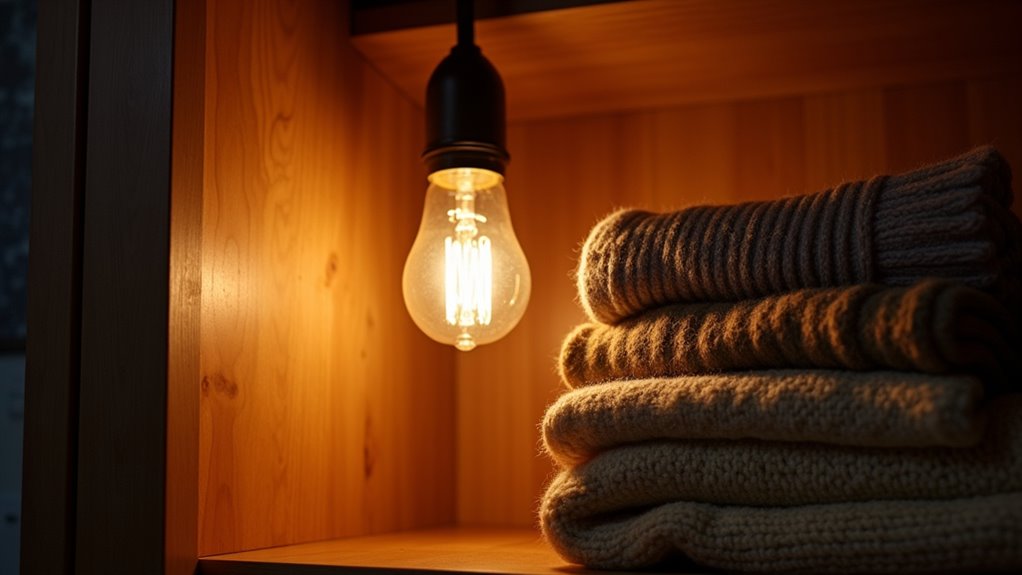
Understanding why clearances exist requires examining the thermal dynamics within enclosed storage spaces. Incandescent bulbs generate significant heat that poses serious combustible material risks when exposed to clothing and linens. You’ll need to guarantee specific clearances: 12 inches for surface-mounted fixtures and 6 inches for recessed luminaires.
The NEC mandates these distances to prevent heat exposure from reaching stored items. Consider these critical factors:
- Fully enclosed luminaires prevent direct heat contact with combustible materials
- LED fixtures provide energy-efficient lighting options while producing minimal heat
- Proper clearance creates a thermal buffer zone between light sources and storage
- Code compliance ensures your installation meets fire prevention standards
These requirements aren’t arbitrary; they’re engineered to prevent ignition scenarios in confined spaces containing flammable materials.
Proper Measurement Techniques for Storage Space Clearances
When measuring closet clearances for lighting installations, you’ll need to establish precise reference points that account for both fixture placement and stored contents. Document your closet’s depth initially; minimum 24 inches guarantees proper hanging clearance, while 26-30 inches accommodates bulkier garments that could contact overhead fixtures. Measure walkway clearances at 36 inches ideal for walk-ins, maintaining code-compliant access to lighting controls.
For appropriate rod placements, verify single rods at 65-70 inches and double configurations at 40/80 inches to determine fixture mounting zones. Calculate ideal shelf depths at 12 inches for accessories, ensuring lighting remains 12 inches from stored materials. Use measuring tape to capture finished interior dimensions, accounting for door swing restrictions and wall plumb variations that affect clearance compliance before installing any electrical components.
NEC and IRC Code Sections Governing Closet Lighting
The National Electrical Code (NEC) Section 410.16 establishes mandatory luminaire requirements specifically for clothes closets, while the International Residential Code (IRC) Section E4003.12 reinforces these provisions for residential applications. You’ll need to understand these code sections when planning outlet load calculations and fixture maintenance requirements for compliant installations.
Key code provisions include:
- NEC Article 410.8 governs luminaires in closets 8 square feet or larger, mandating specific fixture types and clearances
- Section 410.16.A3 and C5 permit specially-rated fixtures for direct contact with stored items when UL Closet Rating Test certified
- IRC E4003.12 requires wall-switch operation for all closet lighting fixtures
- NEC Article 210 addresses branch circuit sizing based on fixture loads and outlet load calculations for proper electrical design
Additional Safety Requirements and Local Code Variations
Beyond the foundational NEC and IRC provisions, your closet lighting installation must address supplementary safety protocols and jurisdiction-specific amendments that directly impact fixture selection and clearance compliance. You must verify that fixtures carry UL certification confirming thermal testing significance for enclosed-space applications. Municipalities frequently impose stricter wattage caps, mandate occupancy sensors, or require photographic inspection evidence before permit approval. Your existing noncompliant fixtures, bare bulbs or pendant lamps present acute fire hazards given clothing combustibility and must be upgraded during renovations. LED fixtures rated specifically for closets generate minimal heat yet still require proper clearances unless zero-inch installation is UL-certified. Routine maintenance importance cannot be overstated: dust accumulation on improperly enclosed bulbs escalates ignition risk. Licensed electricians guarantee adherence to both national standards and local code variations governing fixture types and automatic shutoff requirements.
Frequently Asked Questions
Do Walk-In Closets Have Different Lighting Code Requirements Than Reach-In Closets?
No, you’ll find the NEC makes no distinction between walk-in and reach-in closets for lighting codes. Both require identical fixture types, clearances, and recessed lighting placement standards, 6 inches minimum from stored items for recessed incandescent/LED fixtures. There aren’t separate illumination requirements based on closet size either. You must use fully enclosed fixtures in both configurations, maintain proper clearances, and guarantee AFCI protection regardless of whether you’re installing lighting in a small reach-in or spacious walk-in closet.
Can I Install a Dimmer Switch on My Closet Lighting Fixture?
You can install a dimmer switch on your closet lighting fixture, but codes don’t exempt you from mandatory enclosure and clearance requirements. Your dimmable switch options must pair with fixtures specifically rated for dimming, verify LED bulb compatibility through manufacturer specifications. The fixture still needs full enclosure and proper clearances (12 inches for surface-mounted incandescent/LED, 6 inches for recessed). Thermal management remains critical; even dimmed fixtures can’t overheat near stored items, so choose UL-listed, closet-rated dimmable fixtures.
Are Motion Sensor or Automatic Shut-Off Lights Required in Closets?
No, you’re not required to install motion sensor or automatic shut-off lights in closets under NEC/IRC codes. Manual switches remain fully compliant when you use approved fixtures with proper clearances. However, automatic controls can reduce fire risk from forgotten lights and promote energy savings with energy efficient bulbs. Focus on selecting code-approved fixture types and maintaining proper illumination levels while meeting minimum clearance requirements; your control method choice stays flexible under national electrical codes.
Does Closet Lighting Need to Be on a Dedicated Electrical Circuit?
No, you don’t need a dedicated circuit for closet lighting. The NEC permits closet lights on general 15 or 20-amp lighting branch circuits serving multiple rooms. You must guarantee AFCI protection per NEC 210.12(A) for dwelling units. While energy efficient lighting like LED fixtures is recommended, they can share circuits with other outlets. However, you should verify proper ventilation exists if using enclosed fixtures, and always confirm local code requirements with your building authority.
Can I Use Smart Bulbs or Color-Changing LEDS in Closets?
You can use smart bulbs or color-changing LEDs in closets if they’re fully enclosed in fixtures that meet NEC requirements. Your fixture must completely enclose the bulb, preventing contact with combustible materials. Choose impact-resistant fixtures when possible, and guarantee any smart bulb installation maintains required clearances, 12 inches for surface-mounted, 6 inches for recessed fixtures. While LEDs produce less heat than incandescent bulbs, you’ll still need proper enclosure and flame-retardant material compliance for fire safety.

